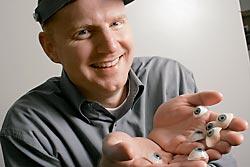Todd Cranmore

Artificial eyes are still painted by hand, one human being gazing into the face of another. More art than science, they're created from hundreds of layers of pigment and acrylic, the relationship between ocularist and patient. Ocularist Todd Cranmore of Kirkland:
Q: Why don't you use digital photography or computers?
A: It looks terrible. A picture is two-dimensional. The eye is three-dimensional. It has shadows, valleys. . . . You could try to analyze and be precise . . . all the elements are there, but when you step back, it doesn't come together, it doesn't look real.
Q: It takes a human touch?
A: I think so. We get to know a patient as we're painting, and I don't know how much of that flows from the brush. (The process takes 8 to 10 hours, several appointments.) Something about doing this for a person who has a need really brings out the pattern, the color, the match. The eye is so detailed, a living tissue. It's a beautiful organ. It can be romantic, it can be stern. There are so many different emotions that can be portrayed in your eyes.
Q: Are you painting emotions?
A: That's interesting because I think we are, but it's probably ours. If we did theirs, in that moment, it's probably going to be anxiety. . . . Someone who's here has gone through a lot of emotional turmoil. They've suffered a loss. There's a grieving process: Denial, anger, acceptance and then forgiveness depending on how they lost their eye. There is quite a bit of healing that needs to take place. . . . Our goal is to really try to restore a patient back to normal.
Q: How do people lose their eyes?
A: Cancer's pretty big, accidents, diabetes, vascular diseases, (birth defects), then rare things like an organism in puppy feces that somehow got into a child's eye and deteriorated it. We still get kids from BB guns. It's almost always the cousin, not intentional. Car accidents. Golf balls. Bungee cords snapping back. One patient kicked by a horse. Used to be more industrial accidents; that's decreased due to safety glasses.
Q: How long do artificial eyes last?
A: About five years. Four years for kids. We see babies every two weeks to resize the eyes because they're growing so quickly.
One patient heading off to college, he said he wanted "girl-catching" eyes. It's interesting to know what that means to a person who has been blind from birth. He said: "Well, they're green." I said, "OK! I can do that."